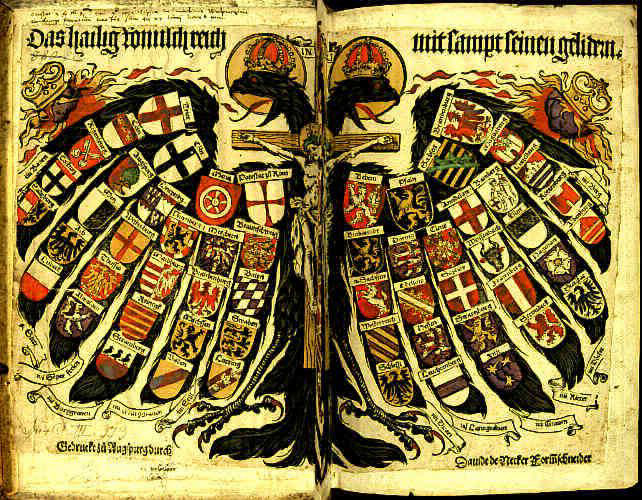Members of the Hohenstaufen family
Family tree of the Hohenstaufen emperors including their relation to succeeding dynasties
Seal of Henry II of Swabia (dated 1216) shows him as a mounted knight with a shield and banner displaying three leopards (three lions passant guardant)as the Hohenstaufen coat of arms; the three lions (later shown just passant) would later become known as the Swabian coat of arms.
Holy Roman Emperors and Kings of the Romans
Conrad III, king 1138–1152
Frederick Barbarossa, king 1152–1190, emperor after 1155
Henry VI, king 1190–1197, emperor after 1191
Philip of Swabia, king 1198–1208
Frederick II, king 1208–1250, emperor after 1220
Henry (VII), king 1220–1235 (under his father Emperor Frederick II)
Conrad IV, king 1237–1254 (until 1250 under his father Emperor Frederick II)
The first ruling Hohenstaufen, Conrad III, like the last one, Conrad IV, was never crowned emperor. After a 20-year period (Great interregnum 1254–1273), the first Habsburg was elected king.
Kings of Italy
Note: The following kings are already listed above as German Kings
Conrad III 1128–1135
Frederick I 1154–1190
Henry VI 1191–1197
Kings of Sicily
Note: Some of the following kings are already listed above as German Kings
Henry VI 1194–1197
Frederick 1198–1250
Henry (VII) 1212–1217 (nominal king under his father)
Conrad 1250–1254
Conradin 1254–1258/1268
Manfred 1258–1266
Dukes of Swabia
Note: Some of the following dukes are already listed above as German Kings
Frederick I, Duke of Swabia (Friedrich) (r. 1079–1105)
Frederick II, Duke of Swabia (r. 1105–1147)
Frederick I, Holy Roman Emperor (Frederick III of Swabia)(r. 1147–1152) King in 1152 and Holy Roman Emperor in 1155
Frederick IV, Duke of Swabia (r. 1152–1167)
Frederick V, Duke of Swabia (r. 1167–1170)
Frederick VI, Duke of Swabia (r. 1170–1191)
Conrad II, Duke of Swabia (r. 1191–1196)
Philip of Swabia (r. 1196–1208) King in 1198
Frederick II, Holy Roman Emperor (r. 1212–1216) King in 1212 and Holy Roman Emperor in 1220
Henry (VII) of Germany (r. 1216–1235), King 1220–1235
Conrad IV (r. 1235–1254) King in 1237
Conrad V (Conradin) (r. 1254–1268)


Dukes of Swabia - Adam von Hohenstaufen of Burgundy
Duchess of Swabia - Evelyn von Hohenstaufen of Savoy
Princess of Swabia - Joyce Leia de Leão e Castela e Borgonha D’ Schwaben e Hohenstaufen
Prince of Swabia - Herbert von Hohenstaufen of Waiblingen
Prince of Swabia - John Albert Solomon von Hohenstaufen

